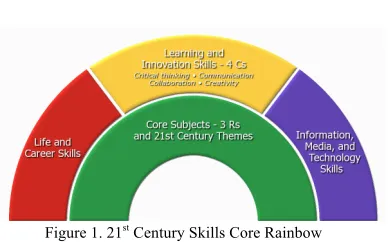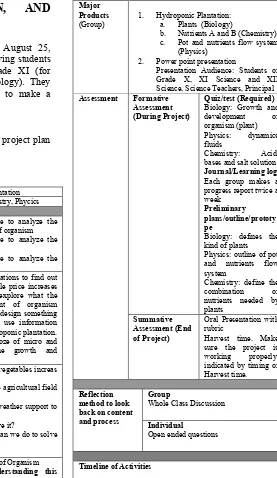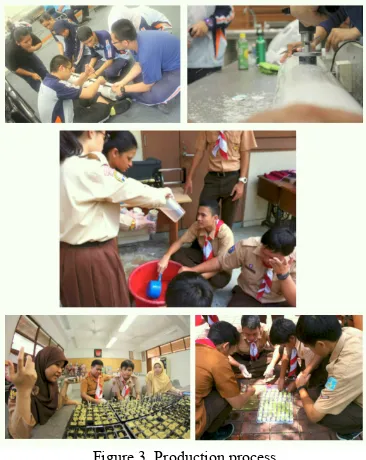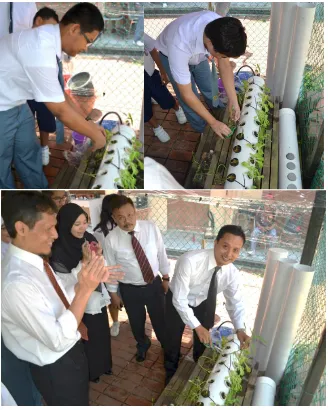INTEGRATED SCIENCE LEARNING THROUGH PROJECT BASED
LEARNING IN SEKOLAH INDONESIA SINGAPURA
Fajar Krisna Caturangga, M.Si.
Sekolah Indonesia Singapura 20A Siglap Road, Singapore 455859
Email: fajar.kc@gmail.com
ABSTRACT
Integrated Science Learning is a learning that combines Physics, Chemistry and Biology into a thematic learning. In this study the Integrated Science Learning conducted through Project Based Learning that emphasizes the analysis of the factual issues and investigating the problem solving by engaging 21st Century skills.
Project Based Learning is centered on the learner and affords learners the opportunity for in-depth investigations of worthy topics. The steps of PBL are: Driving question, designs a plan for the project,
arrange a schedule, monitor/evaluate the progress of the project and assess the outcome.21st Century
skills to be taught and assessed are: critical thinking/problem solving, communication/oral presentation, collaboration, and tech literacy.
Subjects in this study were students of grade X (chemistry subject), grade XI Science (Physics subject) and grade XII Science (Biology subject) at Sekolah Indonesia Singapura.
In this study, aspects of assessment consist of a written test, oral/presentation test and observation. Based on the results of formative tests and summative tests, this study can enhance students' understanding of science and based on the observation during the study, it was concluded that 21st Century skills appears and possessed by the student when the learning processes.
Keyword: Integrated Science Education, Problem Based Learning, 21st Century skills
1. INTRODUCTION
The rapid growth of world population causes the increasing number of the world population. The increasing number of population cause human living spaces is getting less and less. It happens in some Asian Countries. Furthermore, this has impacts on the increasing needs towards energy resources, both biotic and abiotic. Meanwhile, farming and plantation spaces as biotic energy resources are decreasing, and the availability of oil, coal, as well as other abiotic energy resources is in a limited amount. On the contrary the needs towards energy resources in unavoidable. This is as a result of the very fast technology development. It causes strict competition among human beings, as well as among living things to obtain all daily needs for each individual.
“It is not the strongest of the species that survives, nor the most intelligent that survives. It is the one that is the most adaptable to change.” (Charles Darwin, Quote). Based on the above quote, what is required by individual to enable to survive is the capability to adapt to environment, it the environment in this case the current world, situation requires us to make use
of the limited energy resource, while the needs toward energy resources is requested more, hence it’s required creative, innovative, critical individuals and posses the capabilities on using information, therefore they enable to think of solution of every problem they are facing.
How might the capabilities possessed by human being in the future? The answer is certainly through education, namely by making our students to get used to facing problems that might be faced in their environment using the 21st century skills.
For sure, there are many ways of learning methods, which might be applied in education. However, which appropriate method that could trigger those skills to be possessed by students? The researcher tries to use Project Based Learning Models in Integrated Science Learning in order students to posses’ 21st century skills, and to enhance the understanding of science concept on students.
The problems are:
2. Does Integrated Science Learning through Project Based Learning enable to enhance students’ understanding on science concept?
1.1 Integrated Science Education
Integrated Science Learning is a learning that combines Physics, Chemistry and Biology into a thematic learning. In this research, Integrated Science Learning is conducted at high school level, in which the learning of Physics, Chemistry, and Biology are conducted in a separate learning.
1.2 21st Century Skills
On the book written by Bernie Trilling & Charles Fadel entitled 21st Century Skills, Learning for Life in Our Time, has several questions:
“What skills will your child need in the future you painted?”
The answer is what challenges will be faced by our students in the future? Some have been mention earlier, that the availability of energy resources is getting less, on the contrary the need towards energy resources is required more is one of the challenge which might be faced now and in the future.
The core subjects and interdisciplinary 21st Century themes are surrounded by the three sets of skills most in demand in the 21st century:
• Learning and innovation skills • Information, media, and technology
skills
• Life and career skills
Figure 1. 21st Century Skills Core Rainbow
The first set of 21st century skills focuses on critical learning skills and innovation:
• Critical thinking and problem solving (expert thinking)
• Communication and collaboration (complex communicating)
• Creativity and innovation (applied imagination and invention)
1.3 Project Based Learning
Project Based Learning is centered on the learner and affords learners the opportunity for in-depth investigations of worthy topics. The learners are more autonomous as they construct personally meaningful artifacts that are representations of their learning. The steps of PBL are: Driving question, designs a plan for the project, create a schedule, monitor/evaluate the students and progress of the project and assess the outcome.
Why must PBL to appear 21st Century Skills in Integrated Science Learning to anticipate problems that might be happening in daily life?
Because PBL is broader and often composed of several problems students will need to solve, provides the contextualized, authentic experiences necessary for students to scaffold Integrated Science learning and build meaningfully powerful, provide both challenging and motivating. Requires students to think critically and analytically and enhances higher-order thinking skills, requires collaboration, peer communication, problem-solving, and self-directed learning.
The purposes of this research are:
1. To prove that Integrated Science Learning through Project Based Learning enables students to possess 21st Century Skills 2. To prove that Integrated Science Learning
through Project Based Learning enables to enhance students’ understanding on science concept.
The benefits of this research namely:
1. Able to find out that Integrated Science Learning through Project Based Learning will make students to possess 21st Century Skills, and enhance students’ understanding on science concept
2. Able to be references in science learning 3. Able to be the reference in learning using
2.
MODELS,
DESIGN,
AND
IMPLEMENTATION
This research was conducted on August 25, 2013 to September 25, 2013, involving students of grade X (for Chemistry), grade XI (for Physics), and grade XII (for Biology). They worked in a group and together to make a science project.
2.1 Project Plan
This project is conducted based on project plan as presented below:
Table 1. Project Plan
Name of Project Hydroponic Plantation
Project Subject Biology, Chemistry, Phycics
Objective The students will be able to analyze the growth and development of organism The Students will be able to analyze the concept of dynamic fluid
The Students will be able to analyze the nutrition needed by plants
Project idea growth and development of organism needed and collaborate to design something to solve it. Student will use information from sources to make hydroponic plantation. Student find the proper doze of micro and macro nutrient for the growth and development of plant.
Driving question
- Why do the prices of vegetables increas in Singapore?
- Why don’t you see the agricultural field in Singapore?
- Does the Singapore’s weather support to grow the vegetables?
Growth and Development of Organism
As the basis for understanding this organism and from the environment. The internal factors are coming from inside the body, are determined by genes. The world of genes is seen in the work of hormone and enzymes.
Enviromental factors are related to anything in the environment such as air, water, soil,
þ Critical thinking/ Problem solving
þ Communication/Oral presentation
þ Collaboration
b. Nutrients A and B (Chemistry) c. Pot and nutrients flow system
(Physics) 2. Power point presentation
Presentation Audience: Students of Grade X, XI Science and XII Science, Science Teachers, Principal
Assessment Formative bases and salt solution
Journal/Learning log
Each group makes a progress report twice a week
Chemistry: define the combination of
Oral Presentation with rubric group (Product: Project outline), arranges the schedule. Assessment: Observation assessment
Week 2: Running project (Product: progress report twice a week),
Assessment: Formative test and observation assessment
Week 3: Running project (Product: progress report twice a week),
Assessment: Observation assessment
Week 4: Prepare to final report, Group presentation and discussion, and Harvest time!
Assessment: Summative test and Observation assessment
Daily schedule: The Project is run after school hour everyday (Mo-Fri)
2.2 Assessment Methods
Kinds of the assessment are:
1. Formative test comprises 5 (five) concept questions for each science subject. The total score is 100.
2. Summative test conducted in the form of oral presentation test, consisting 2 (two) kinds of assessment namely: understanding of Science concept and communication skill (on observation assessment). The understanding of Science concept assesses using the rubric as presented in the following.
Table 2. Summative test rubric
Name Subject Understanding concept Total Score 1 2 3 4 5
Notes:
- Comprises 5 (five) concepts of each subjects, in accordance with the indicator of each Science subject
- Score range used is 1 – 4
- 4 = very good, 3 = good, 2 = enough, 1 = poor
the final mark for understanding concept is calculated using the following formula:
𝑚𝑎𝑟𝑘=
𝑡𝑜𝑡𝑎𝑙𝑠𝑐𝑜𝑟𝑒
20 ×100
3. Observation assessment is conducted during the ongoing project. Science teacher conducts observation. The observation sheets on 21st Century Skills is as follows.
Table 3. Observation assessment rubric
Name 21st Century Skills Total score
1 2 3 4
Notes:
- 1:critical thinking/problem solving, 2:communication/oral presentation, 3:collaboration, 4:Tech literacy
- Score range used is 1 – 4
- 4 = always, 3 = often, 2 = sometimes, 1 = never
Observation result can be calculated using the following formula:
𝑚𝑎𝑟𝑘=
𝑡𝑜𝑡𝑎𝑙𝑠𝑐𝑜𝑟𝑒
16 ×100%
Criteria:
90<mark≤100=very good 80<mark≤90=good
70<mark≤80=enough
3. STUDY RESULT
Figure 2. Process of pot and nutrients flow design
Figure 3. Production process
The result of formative test (F), summative test (S) and Observation assessment in average each group as follows:
Table 4. Study Result
Group Subject F S O
X Chemistry 56 79 79 %
XI Physics 62.86 88.57 94.62 %
XII Biology 60 80 82.50 %
average 59.62 82.52 85.37 %
On the observation result, the appearance of 21st century skills, which is researching 4 kinds of basic skills reveals, that group X (Chemistry) shows the average result 79%, group XI (Physics) show 94.62% and group XII (Biology) show 82.50%. From this data, hence Integrated Science Learning through Project Based Learning can appear 85.37% in average out of 21st century skills is researched. The percentage shows that the mastery of 21st century skills for students when the project is in progress is considered good (80 < mark < 90)
Figure 4. Harvest time
4. CONCLUSION
Based on the result of the discussion above, it can be inferred namely:
1. Integrated Science Learning through Project Based Learning enables to enhance the students’ understanding on Science concept.
2. Integrated Science Learning through Project Based Learning enables to make students to possess 21st Century Skills.
REFERENCES
1. A Global Cities Education Network Report, 2012, “Teaching and Learning 21st Century Skills: Lesson from the Learning Sciences”, Rand Corporation. Hong Kong.
2. Bernie Trilling & Charles Fadel, 2009, “21st Century Skills, Learning For Life in Our Time”, John Wiley & Sons Inc., San Francisco.
3. Jason Ravitz and Friends, 2012, “Using Project Based Learning to teach 21st Century Skills: Finding from a statewide initiative”, Paper, Vancouver, BC.
4. Robert M. Capraro and Scott W. Slough, 2009, Project Based Learning An Integrated Science, Technology, Engineering and Mathematics (STEM) Approach, Sense Publisher, Rotterdam.
5. Kementrian Pendidikan dan Kebudayaan RI, 2014, “Modul Pelatihan Implementasi Kurikulum 2013, Badan Pengembangan Sumber Daya Manusia Pendidikan dan Kebudayaan dan Penjaminan Mutu Pendidikan, Jakarta.



